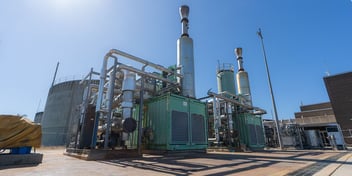Like “a pressure cooker for sludge”: The case for thermal hydrolysis
For wastewater treatment plant (WWTP) operators, thermal hydrolysis can significantly reduce the quantity of biosolids produced and create a better-quality product, leading to potential cost savings for utilities.
Thermal hydrolysis is a treatment process that uses high temperature and pressure to partially dissolve sewage sludge before traditional anaerobic digestion.
“Thermal hydrolysis is really a pressure cooker for sludge that improves the degradability of hard to digest biosolids,” GHD Senior Technical Director – Water and Biosolids Process David Solley said ahead of his presentation at the AWA/ANZBP Biosolids National Conference next year.
“A good analogy is a potato: If you ate a raw potato, not a lot would happen. But if you cooked the potato and mashed it, it would become more digestible.”
Solley said thermal hydrolysis pretreatment can help create a more stable product with a lower odour and fewer pathogens, that also dewaters more effectively compared to just using anaerobic digestion. It also results in better solids reduction and conversion to biogas.
Another major benefit is reduced sludge viscosity, which means digestion reactors used downstream can be about half the normal size.
“It makes the whole process of anaerobic digestion a lot more efficient … You can make really big changes in the mass of the sludge produced, which is the biggest cost,” he said.
“It usually turns out to be quite an economic alternative and has good environmental benefits.”
For example, using thermal hydrolysis pretreatment – where all the sludge is put through the process – can result in an almost pathogen-free product.
Solley, along with GHD Team Leader – Treatment, Technical Director Rahul Chhillar, analysed different thermal hydrolysis process configurations to assess their effectiveness.
They found pretreatment hydrolysis had advantages when compared with other options such as loop hydrolysis. This is where the process is applied in a recirculation loop, with sludge being taken out of the anaerobic process through thermal hydrolysis and returned to the digester.
Solley said pretreatment hydrolysis produces a better result using a smaller reactor and at a cheaper cost.
“We think pre-hydrolysis has advantages, especially if you’re looking to intensify the process and make the digester reactors smaller, which is a big part of the cost,” Solley said.
“Based on modelled data, we also believe it would give a better reduction of solids and higher gas production.”
Solley visited one of the first thermal hydrolysis plants in Denmark in 2000, which was the first plant treating waste activated sludge only.
Queensland Urban Utilities adopted this technology and installed the first thermal hydrolysis plant outside of Europe at its Oxley Creek site in 2007. Since then, Solley said the practice has gained ground around the world, and more recently in Australia.
“There are now more than 50 plants worldwide. It’s one of those slow-build things, but it’s really starting to take off now,” he said.
“That’s not to say it’s necessarily an easy thing to do.”
One of the main challenges of implementing thermal hydrolysis for WWTPs is that it is a completely new process. The complex nature of the treatment – and the inherent safety risk of working with 160°C sludge and 200°C steam – also means it’s limited to larger plants.
“It’s usually outside the skillset of a WWTP operator … You can manage the safety aspects but it’s just not something that is common in wastewater treatment at present,” Solley said.
“Usually in wastewater plants we’re focused on water, solids and the nutrient balance, but to get the thermal hydrolysis process right you need to consider the energy balance in the plant and how to manage that energy.”
Thermal hydrolysis helps extract more energy from biosolids, which can be exported to the grid or used to help power the plant. Solley said this is often the reason WWTP operators want to implement the process, but that there are other reasons to do so.
“A lot of the time people seem to be focused on electricity production, but I think the benefits are more to do with the end product,” Solley said.
“I think the great benefit is you get a better-quality product and a lot less of it. Secondary to that, it’s a viable alternative to anaerobic stabilisation and reduces the cost because it intensifies the process so much.”
David Solley will be presenting at the ANZBP Biosolids conference in February 2019.
Related podcast:
https://omny.fm/shows/australianwater/richard-lovett-on-sludge-treatment-options-analysi

